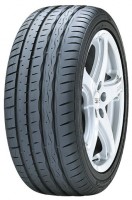Hankook Tire America Corp. Offers Consumers Tire Safety Tips
 Wayne, NJ — In coordination with National Tire Safety Week, Hankook Tire America Corp. is offering tips and advice to arm consumers with the tire safety knowledge necessary to ensure that their tires are in good working condition for summer travel.
Wayne, NJ — In coordination with National Tire Safety Week, Hankook Tire America Corp. is offering tips and advice to arm consumers with the tire safety knowledge necessary to ensure that their tires are in good working condition for summer travel.
Tires are the only part of the vehicle that makes contact with the road. Therefore, it’s important to follow these simple guidelines to ensure safe driving and save money no matter what your destination may be this summer.
“Not maintaining proper tire inflation pressure costs consumers hundreds of dollars during their driving lifetime,” said Bill Bainbridge, director of brand communications for Hankook Tire America Corp. “Even slightly underinflated tires require more energy and build up damaging heat more quickly. This leads to reduced fuel economy and paying more for gas than you need.”
- Check tire air pressure monthly and always before a long distance trip. Maintaining proper inflation pressure is essential for driving safety, handling, ride comfort and maximizing fuel economy.
- Inspect tires for uneven treadwear that may indicate signs of mechanical problems, and/or cracks, bulges or any sign of foreign material or trauma that can lead to tire failure. If you think your tire may have been damaged from hitting a pothole, curb or debris on the road, it should be inspected for damage by a qualified person, such as a Hankook authorized tire dealer.
- Check your tire tread depth. As tires wear down and the grooves become shallower, they are more prone to hydroplaning (losing grip on a wet surface) and susceptible to flats. Tires must be replaced before the tread grooves are worn down below 2/32″ of depth. Most tires have between four and six treadwear indicators at that depth.
- Never overload your vehicle or exceed the tire’s load carrying capacity when it is properly inflated. Refer to your vehicle owner’s manual or the placard on the inside driver’s door jam for proper recommendations.
 In addition, said Bainbridge, “Tires that wear unevenly and more quickly as a result of improper inflation will cause consumers to spend more on vehicle maintenance and to replace tires more often. A little common sense and a few minutes each month can add up to a lot of dollars saved.”
In addition, said Bainbridge, “Tires that wear unevenly and more quickly as a result of improper inflation will cause consumers to spend more on vehicle maintenance and to replace tires more often. A little common sense and a few minutes each month can add up to a lot of dollars saved.”
It’s important to remember that when tires are underinflated they are overloaded and can be dangerous. For the best accuracy, check your tires before you do any driving and when they are cold. An inexpensive tire air pressure gauge is all you need along with the proper inflation pressure recommendation found on the vehicle placard or in the vehicle owner’s manual.
Selecting the Right Replacement Tire – Quality is Key
When replacing the tires that came as original equipment on your vehicle, you should always refer to your vehicle owner’s manual and rely on an authorized tire retailer for advice to ensure that you make the best and safest choice. In fact, there may be multiple tire options that you may want to consider that fit your vehicle, all while maintaining an appropriate tire size, speed rating, load range, etc.
In addition to size, model and type, there are other qualifications to consider when replacing tires. Three important factors make up the Uniform Tire Quality Grading Standard (UTQG) developed to provide consumers with useful information to help them compare passenger car tires based on their relative treadwear, traction and temperature capabilities. While these UTQG standards aren’t perfect, they can help consumers narrow their purchase decision.
“The higher the treadwear rating the longer the tire should wear,” said Tom Kenny, manager of tire development engineering, Hankook Tire America Corp. “Traction represents the tire’s stopping ability on wet asphalt and concrete surfaces. The highest traction rating is AA followed by A, B and C. Temperature measures how well a tire dispels heat and how well it handles heat build up. Tire temperatures are rated A, B and C respectively.”
How Many to Replace?
Most cars require replacing tires in sets of two or four. It’s rare that one tire will wear down much more quickly than the other three. “Rotating tires every 5,000 to 7,000 miles and checking tire pressure regularly helps to ensure that all four tires will wear down evenly,” Kenny said. “If it is necessary to replace two tires at a time, make sure the new tires are mounted on the rear axle to provide better grip, which reduces the vehicle’s potential to hydroplane in wet conditions.”
Tire’d Out?
Following these simple checks, maintaining proper tire inflation, rotating tires every 5,000 to 7,000 miles, and replacing worn tires when necessary will help to control costs and maximize performance and safety in all driving conditions. More information on tire safety and basic maintenance can be found at www.hankooktireusa.com under the ‘Service & Support’ tab.
About Hankook Tire America Corp.
Headquartered in Wayne, N.J., Hankook Tire America Corp. is a technology-focused, market-driven company that markets and distributes a complete line of high performance and ultra-high performance passenger tires, light truck, SUV tires, as well as medium truck and bus tires to more than 400 independent dealers through 3000+ retail sales locations in the United States and Canada.
For more information, please visit the Hankook website at www.hankooktireusa.com.


